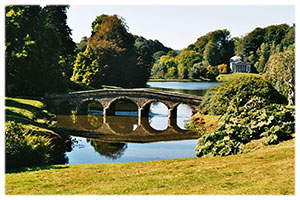Playwright Tom Stoppard has remarked that, in putting a play together, “what happens is you pull in all sorts of ideas which previously had been quite disconnected, which had been floating around in one’s mind for years…As usual I found that one has a play to write at the point where different threads, quite separate threads, begin to join up.” In Arcadia, four main threads join up over the course of the play and we will provide a little information about each of them in blog entries. All of these subjects —Classical and Romantic thought; “natural” gardens and the “picturesque”; Lord Byron and Lady Caroline Lamb; and chaos theory — intertwine their way through Arcadia, easily one of Stoppard’s most ambitious plays in what has been an incredibly ambitious writing career.
English Gardens
 “The grounds of Sidley Park, the house which provides the setting for Arcadia, are a palimpsest on which all three of the main styles of 18th and early 19th century landscape garden have at one time or another been inscribed. Until the 1750s, the garden was laid out according to an aesthetic which saw beauty only in symmetry, in the geometrical pattern made by circular pools and the intersecting straight lines of avenues, allées, terraces, hedges. This formal design was then buried beneath the improvements of Lancelot (‘Capability’) Brown, the most famous advocate of a ‘natural’ style of gardening which saw beauty only in asymmetrical arrangements of sinuous curves and trees planted in loosely, scattered informal groups. As Arcadia opens, this design is about to give way to the ‘picturesque’ style favored by Mr. Noakes. The ‘picturesque’ was an aesthetic of irregularity, of ‘romantic’ wildness, in which the continuous, serpentine lines of Brown were deliberately broken and obscured by sudden declivities and the jagged shapes and shadows of rocks and unkempt trees.” — John Barell, from the program for Arcadia’s 1993 world premiere at the National Theatre, London
“The grounds of Sidley Park, the house which provides the setting for Arcadia, are a palimpsest on which all three of the main styles of 18th and early 19th century landscape garden have at one time or another been inscribed. Until the 1750s, the garden was laid out according to an aesthetic which saw beauty only in symmetry, in the geometrical pattern made by circular pools and the intersecting straight lines of avenues, allées, terraces, hedges. This formal design was then buried beneath the improvements of Lancelot (‘Capability’) Brown, the most famous advocate of a ‘natural’ style of gardening which saw beauty only in asymmetrical arrangements of sinuous curves and trees planted in loosely, scattered informal groups. As Arcadia opens, this design is about to give way to the ‘picturesque’ style favored by Mr. Noakes. The ‘picturesque’ was an aesthetic of irregularity, of ‘romantic’ wildness, in which the continuous, serpentine lines of Brown were deliberately broken and obscured by sudden declivities and the jagged shapes and shadows of rocks and unkempt trees.” — John Barell, from the program for Arcadia’s 1993 world premiere at the National Theatre, London
The development of landscape garden architecture in Britain during the 18th and 19th centuries parallels the transition from Classicism to Romanticism. A growth in nationalistic pride (and a consciousness of its differences between its government and the absolute monarchies of continental Europe) prompted Britain to cultivate a distinctly British identity throughout the 18th century. Classical, symmetrical gardens, the dominant style prior to the mid-18th century, were seen as too French— too ordered and confining. Brown’s “natural” style better reflected the more enlightened and egalitarian position that Britain occupied on the world stage. As a result, many country manors had their gardens remodeled.
By the beginning of the 19th century, however, in the wake of the American and French Revolutions, Britain (with its constitutional monarchy still intact) could no longer claim to be at the forefront of Progressivism. Inspired by the growth of Romanticism, picturesque gardens changed the British narrative once again, from one of youthful exceptionalism to one of deep-rooted tradition that would not be altered by the latest fad, political or otherwise. In Arcadia, the architect Mr. Noakes is an advocate of the “picturesque” style and is persuading the 19th century Coverlys to remodel their garden under his guidance, despite the objections of Lady Croom who prefers the “natural” style already present.
More on Arcadia:
Articles | Production Details | Tickets
Further Reading
Fleming, John. Tom Stoppard’s Arcadia. London: Continuum, 2008.
Hunt, John Dixon and Peter Willis, ed. The Genius of the Place: The English Landscape Garden 1620-1820. Cambridge: The MIT Press, 1988.
Nadel, Ira. Tom Stoppard: A Life. New York: Palgrave Macmillan, 2002.


No comments yet.